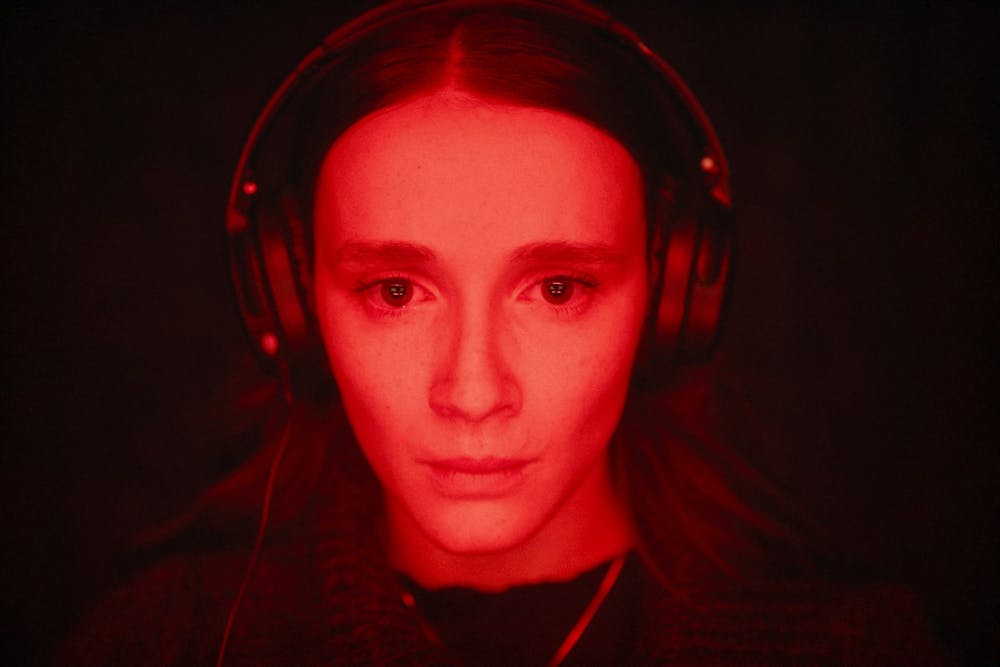First, a disclaimer: talking about this film to those who haven’t seen it can be a bit messy. A few elements that some consider to be big reveals are described by others as the very premise of the movie. Some of my descriptions may be a bit vague, since I’m staying on the conservative side to make sure I avoid any spoilers. If you’re interested in the full blind experience, this article should be safe, but I would recommend steering clear of even the Google synopsis.
“Red Rooms” is a French-Canadian psychological thriller about the trial of a sadistic killer who live streamed his exploits on the dark web. Rather than center the killer or the prosecution itself, save for an impressive long-take sequence of the lawyers’ opening arguments to begin the film, “Red Rooms” focuses on the trial’s observers. It follows Kelly-Anne (Juliette Gariépy), an affluent, reclusive, tech-savvy model and online poker aficionada. Her motives are unknown for much of the runtime, but it’s clear she’s developed an unhealthy obsession with the case.
“Red Rooms” is a movie I really wanted to like. Beyond its intriguing premise, which promises to delve into the perils of the internet and society’s morbid fascination with true crime, the film is technically impressive. It’s well-directed, creating suspense and discomfort from the simplest of expressions and shots; it’s well-scored, accentuating the mood through atmospheric droning and dramatic orchestral flourishes; and it’s well-shot, employing a gorgeous contrast of warm and cool colors throughout. Writer-director Pascal Plante has a clear, confident vision.
To fans, the film is a captivating look at the psychology of obsession. Each principal character showcases obsession in a different form: the oft-competing obsession with justice and obsession with answers, one audience member’s infatuation with the killer that convinces her of his innocence, and even the striking similarities in each of the killer’s victims and techniques.
The most nuanced portrayal comes through Kelly-Anne, whose obsession lies not in any of the figures of the case but in the idea of the act itself. As we see more of her interior life, it becomes clear Kelly-Anne is not mentally stable despite her highly regimented lifestyle.
But is “Red Rooms” actually that captivating? The film has little-to-no plot until the final 20 minutes, when Kelly-Anne’s motivations are revealed. And they’re not particularly shocking. To be clear, “no plot” isn’t a criticism in itself. Plenty of films achieve success not through complex plots but through atmosphere, character or message. Still, it’s difficult to laud “Red Rooms” as a successful character study when the character it’s studying only visits a few sketchy websites. The bulk of the movie is hollowly setup — a nonetheless moody, well-crafted setup — for a mediocre payoff.
The most frustrating part is that the payoff could have easily been more satisfying. If Kelly-Anne’s goal was revealed earlier in the film, we could have seen the multiple steps she takes to achieve it and witness her slow spiral into obsession as she goes deeper and deeper. A feature-length version of watching Kelly-Anne trying and failing to do something she does relatively easily in the climax of the film would be quite compelling.
What’s more, Kelly-Anne ends up affecting the trial’s trajectory, but there’s nothing to indicate the trial wasn’t already moving in that direction. It’s frankly baffling that Plante chose not to rewrite minor details of this wholly fictional trial so the plot of the movie would actually become significant.
“Red Rooms” also showcases how the internet enables dark places in our society that were previously less accessible. Bitcoin is used for evil and for the mundane. A scene in which a witness explains to the jury how Tor, a deep web browsing application, works is one of the highlights of the film. There are hints of commentary on how violence becomes commoditized and sensationalized through modern media just as much as on the dark web.
At the risk of comparing any thriller that showcases modern technological horrors to “Black Mirror,” “Red Rooms” would feel right at home as a “Black Mirror” episode, and not just because the lead character evokes an edgier version of Bryce Dallas Howard. In fact, “Red Rooms” may have actually worked better as an episode of TV. The high production value would be more impressive, and the format and expectations would make withholding basic character information more palatable (“Shut Up And Dance,” anyone?).
As it stands, “Red Rooms” is perhaps the most disappointing film that has still left me eager to see what its director does next.






